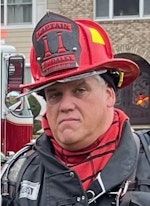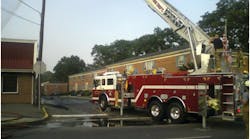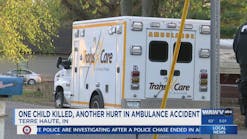Positioning Aerial Apparatus for Defensive Operations
Recently, we discussed apparatus positioning for truck companies at the scene of a working fire, and we approached this topic with considerations towards operating in an offensive mode; that is, crews were going to be assigned specific areas of the structure and perform assigned tasks with the engine companies working inside to find the seat of the fire. This month, we take an alternative view and discuss some of the same topics taking into consideration that operations will be strictly defensive, or from the exterior of the structure. While many people feel that this is an overall safer approach to fighting the fire, there have been many instances where operating in such a manner has resulted in a significant line-of-duty injury or death. Our discussion this month will provide some points of consideration to keep you and your crew members safely protected on the fire scene.
Why Defensive?
Much to the distain of many firefighters, many times we find ourselves outside the confines of the structure attempting to extinguish the fire raging within. It is in our nature to be aggressive and efficient; however, this is a trait that can land us in significant danger, sometimes with catastrophic results (see Photo 1). Progressive officers and incident commanders must evaluate the “bigger picture,” and have the wisdom to make the defensive call when the need arises. In my years as a fire officer and an incident commander (IC), there are a few “clues” that almost always scream Defensive:
Buildings that have burned before: For some reason, somebody, somewhere, wanted that building to burn. Usually when responding back the second (or third) time, the fire is larger and much more developed during the previous alarm.
Buildings under construction: Structures that are still in the early phases of construction are nothing more than stacked lumberyards, and in today’s construction practices, are filled with larger open void spaces and engineered structural components (i.e., lightweight components). Open void spaces will result in rapid ventilation and fire spread, making the defensive posture upon arrival the most prudent decision (see Photo 2).
Buildings that are abandoned/under demolition: While this may seem like a common sense decision, many times firefighters are injured or killed risking their lives for no sustainable life hazard or property (see Photo 3). The building is coming down, no matter how aggressive the attack.
Adding to the list of clues, there are some significant construction issues that should cause concern in the mind of the IC:
Cornices:These ornate decorative moldings originally were designed to throw rainwater away from the front wall of a structure, but they also serve as a significant collapse hazard. Whether they are eccentrically secured to the front wall, or designed to be freestanding, they can come crashing down with little or no warning (see Photo 4).
Parapet Walls: A freestanding extension of the front wall of a building, they can also have coping stones around the top edge of the wall, compounding the total weight of the assembly. Connections made from the parapet to the structure are limited, and usually are exposed to the elements, resulting in deterioration of the connections. Furthermore, heavy fire will begin to distort the lintel the parapet rests on; the twisting of the steel span will result in the assembly failing as an entire unit.
Tension Rods: These rods can be cable or threaded materials, and are utilized to hold parallel masonry walls together. At each end of the rod, there is a protrusion of the rod through the wall where a connection is made to a spreader plate, which is used to distribute the load throughout the wall. Many times the original plans for the structure included tension rods in the construction process; in this case, the rods will look symmetrical in nature, orderly and aligned throughout the structure. An alarm should go off when these rods are located throughout the structure in various sporadic locations (see Photo 5). Furthermore, these assemblies have been proven to fail at around 800°F, leading to total wall assembly failure.
Hybrid Construction: This process uses mixed types of materials and construction practices as the building is assembled. The variations in materials and design make it very difficult to prescribe this structure to any basic type of construction class. Moreover, it can be found in any type of occupancy (see Pk coohoto 6). The only way to truly identify its presence is through thorough pre-planning.
Bowstring Truss Roofs: Easily identifiable by its arch design from the exterior, this assembly has been the cause for many firefighter fatalities throughout the years. This roof assembly will push all four walls of the structure outward: the arched assemblies in compression force the walls outward as well as downward. Furthermore, hip rafters that connect the front and rear walls to the roof assembly will force out these walls when the roof fails. Many unsuspecting firefighters operating near the front wall have been seriously hurt or killed when the collapse occurs.
Setting the Aerial up for Success
Truck companies will find themselves in the front lines of the defensive attack, as the reach and penetration from the elevated stream allows for water to be applied without the risk to the firefighting crew. Take into account a few points to find the best spot to set up:
1. Wind direction – Set up upwind so that water spray from the elevated stream goes on the fire and the downwind exposure.
2. Monitor the collapse zone – The fire attacking the structure is damaging the “Gravity Resistance System” (Frank Brannigan refers to this in his book Building Construction for the Fire Service) in the construction and design of the structure. Furthermore, every stream that is flowing 500 gpm into the building is adding about two tons of additional weight to the structure. Be sure to stay out of the collapse zone, which is usually one and one-half times the height of the building, and take a flanking position from the exterior walls of the structure (photo 7).
3. Identify the most significant exposure – Ladder companies will be discharged with exposure protection, so determine which one is most at risk. Two major points to consider include the distance the exposure is from the original fire building, and the height of the exposure building. Spacing from the original fire building is advantageous as the heat transfer from convection and radiant heat will be limited the further the exposure is from the fire building. If the exposure building is taller than the fire building, then the exposed area immediately above the fire building is a vulnerable area.
4. Spot for maximum scrub – Setting up to cover the most area of the fire building and the exposure will maximize the efficiency of the device. Pick the location that will give the most access for the device, and consider any overhead obstructions that will be problematic for the operator (photo 8).
5. Water application – The chemistry of combustion and the rate of heat release remain constant, so the attack methods are similar, whether the attack is offensive or defensive. Keep in mind the condition of the roof or ceiling; as long as a roof/ceiling exist, then the application of water can be done through the center of the window, at a 30° angle upward towards the ceiling, played back and forth throughout the space. Once the roof has failed, the attack may be made from above, as long as it does not push the fire back downward throughout the rest of the structure (photo 9).
Conclusion
Firefighters can fall into a false sense of security while operating outside the structure. A belief that operations are completely safe from the exterior can result in catastrophic consequences when safe practices are ignored. Defensive operations and elevated streams from aerial devices can be extremely hazardous; make certain the safety parameters that are in place are strictly adhered to, so everyone goes home.
Until next time, stay focused and stay safe.
MICHAEL DALEY, a Firehouse.com Contributing Editor, serves as Lieutenant with the Monroe Township Fire District No. 3 and he was recently earned the Master Fire Instructor certification from the ISFSI. He is an instructor at the Middlesex County Fire Academy where he developed rescue training cirriculum and serves on New Jersey Task Force 1. He is a managing member of Fire Service Peformance Concepts and a monthly columnist on Firehouse.com. He has been on a guest on numerous Firehouse Podcasts, including: Basement Fire Tactics Roundtable at Firehouse Expo, The Buzz on Technical Rescue: A Look at the USAR Equipment Cache, and Rapid Intervention from East to West.

Michael Daley
MICHAEL DALEY, who is a Firehouse contributing editor, recently retired as a 37-year veteran who served as a captain and department training officer in Monroe Township, NJ. He is a staff instructor at multiple New Jersey fire academies and is an adjunct professor in the Fire Science Program at Middlesex County College. Daley is a nationally known instructor who has presented at multiple conferences, including Firehouse Expo and Firehouse World. His education includes accreditations as a Chief Training Officer and a Fire Investigator, and he completed the Craftsman Level of education with Project Kill the Flashover. Daley is a member of the Institution of Fire Engineers and a FEMA Instructor and Rescue Officer with NJ Urban Search and Rescue Task Force 1. He operates Fire Service Performance Concepts, which is a training and research firm that delivers and develops training courses in many fire service competencies.







